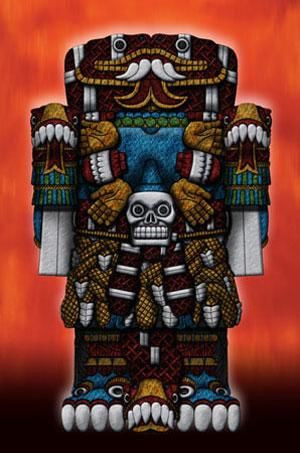
In the pantheon of Aztec deities, Coatlicue holds a formidable place. Known as the "Serpent Skirt," she embodies the complex interplay of life, death, and rebirth, a central theme in Aztec mythology. This article delves into the rich tapestry of myth and symbolism surrounding Coatlicue, revealing the depth and complexity of Aztec spiritual beliefs.
The Legend of Coatlicue
Coatlicue, whose name means "the one with the skirt of serpents," is often depicted as a fearsome figure. She is characterized by her skirt made of writhing snakes and a necklace of human hearts, hands, and a skull. Her visage is two serpent heads facing opposite directions, symbolizing the duality of life and death.
According to Aztec mythology, Coatlicue was the mother of Huitzilopochtli, the god of sun and war. One of the most dramatic legends about her tells of how she became pregnant with Huitzilopochtli. As the story goes, Coatlicue found a ball of feathers that fell from the sky and placed it in her waistband, becoming miraculously pregnant. Her other children, the Centzon Huitznahua (the stars), and her daughter Coyolxauhqui, enraged by this miraculous conception, plotted to kill her. Huitzilopochtli emerged fully armed from Coatlicue's womb and defended his mother by slaying Coyolxauhqui and her brothers.
Symbolism and Significance
Coatlicue is more than just a figure of myth; she is a representation of the Aztec understanding of the cosmos. Her dual serpent head symbolizes the duality inherent in Aztec beliefs—the coexistence of life and death, creation and destruction. The Aztecs saw these forces as complementary rather than opposing, a concept deeply embedded in their rituals and daily life.
Her role as the mother of gods and mortals alike ties her to the earth and fertility, while her skirt of serpents connects her to the underworld. This connection underscores the Aztec belief in the cyclical nature of life, where death gives way to new life, and destruction leads to creation.
Cultural and Historical Impact
The worship of Coatlicue was central to Aztec religion, reflecting the importance of female deities in their pantheon. Her temple in Tenochtitlan, the Aztec capital, was a site of significant religious importance. The massive stone sculpture of Coatlicue, discovered in 1790 in Mexico City, stands as a testament to the artistic and religious achievements of the Aztec civilization.
Modern Interpretations
Today, Coatlicue remains a potent symbol in Mexican culture, embodying the fusion of pre-Hispanic and contemporary Mexican identities. She has been reinterpreted by modern artists and writers, often as a symbol of indigenous heritage and resistance against colonialism.
Conclusion
Coatlicue's enduring legacy reflects the depth of Aztec spirituality and its ongoing influence. As a deity embodying the cycles of life and death, she reminds us of the perpetual rhythms of the natural world and the enduring power of myth to convey fundamental truths about our existence. In Coatlicue, we find not only a deity from a bygone era but a timeless symbol of the interconnectedness of life, death, and rebirth.
The Legend of Coatlicue
Coatlicue, whose name means "the one with the skirt of serpents," is often depicted as a fearsome figure. She is characterized by her skirt made of writhing snakes and a necklace of human hearts, hands, and a skull. Her visage is two serpent heads facing opposite directions, symbolizing the duality of life and death.
According to Aztec mythology, Coatlicue was the mother of Huitzilopochtli, the god of sun and war. One of the most dramatic legends about her tells of how she became pregnant with Huitzilopochtli. As the story goes, Coatlicue found a ball of feathers that fell from the sky and placed it in her waistband, becoming miraculously pregnant. Her other children, the Centzon Huitznahua (the stars), and her daughter Coyolxauhqui, enraged by this miraculous conception, plotted to kill her. Huitzilopochtli emerged fully armed from Coatlicue's womb and defended his mother by slaying Coyolxauhqui and her brothers.
Symbolism and Significance
Coatlicue is more than just a figure of myth; she is a representation of the Aztec understanding of the cosmos. Her dual serpent head symbolizes the duality inherent in Aztec beliefs—the coexistence of life and death, creation and destruction. The Aztecs saw these forces as complementary rather than opposing, a concept deeply embedded in their rituals and daily life.
Her role as the mother of gods and mortals alike ties her to the earth and fertility, while her skirt of serpents connects her to the underworld. This connection underscores the Aztec belief in the cyclical nature of life, where death gives way to new life, and destruction leads to creation.
Cultural and Historical Impact
The worship of Coatlicue was central to Aztec religion, reflecting the importance of female deities in their pantheon. Her temple in Tenochtitlan, the Aztec capital, was a site of significant religious importance. The massive stone sculpture of Coatlicue, discovered in 1790 in Mexico City, stands as a testament to the artistic and religious achievements of the Aztec civilization.
Modern Interpretations
Today, Coatlicue remains a potent symbol in Mexican culture, embodying the fusion of pre-Hispanic and contemporary Mexican identities. She has been reinterpreted by modern artists and writers, often as a symbol of indigenous heritage and resistance against colonialism.
Conclusion
Coatlicue's enduring legacy reflects the depth of Aztec spirituality and its ongoing influence. As a deity embodying the cycles of life and death, she reminds us of the perpetual rhythms of the natural world and the enduring power of myth to convey fundamental truths about our existence. In Coatlicue, we find not only a deity from a bygone era but a timeless symbol of the interconnectedness of life, death, and rebirth.